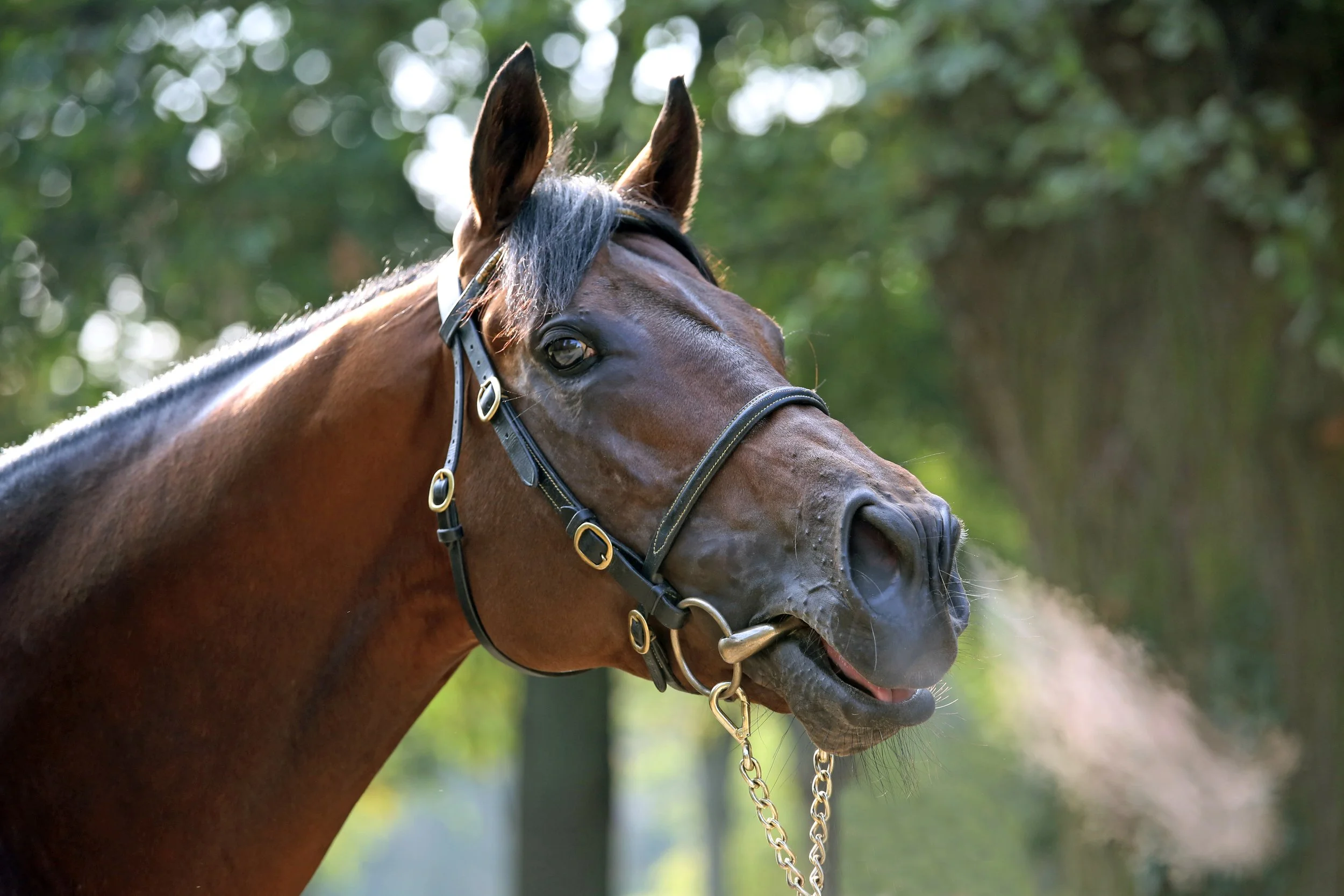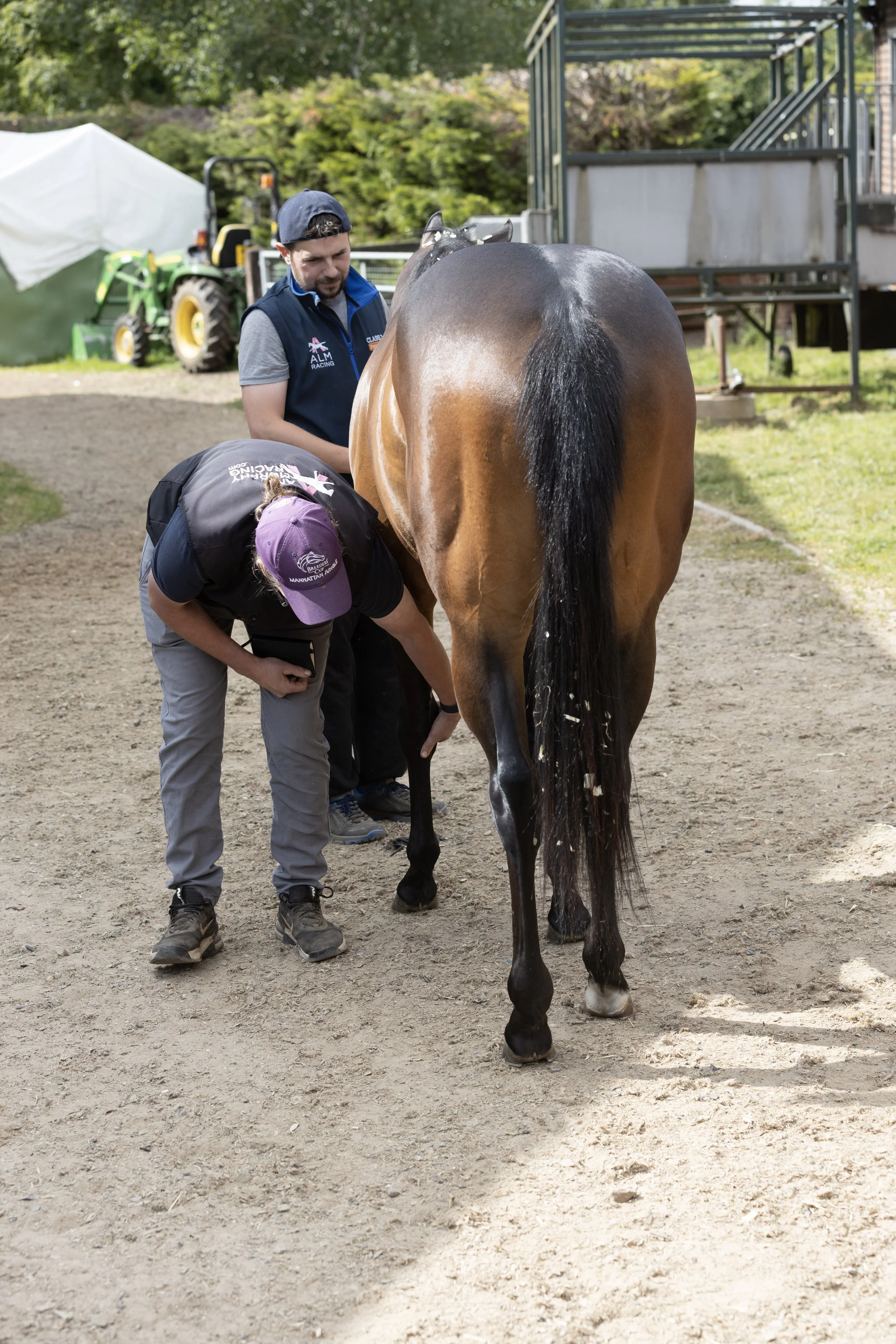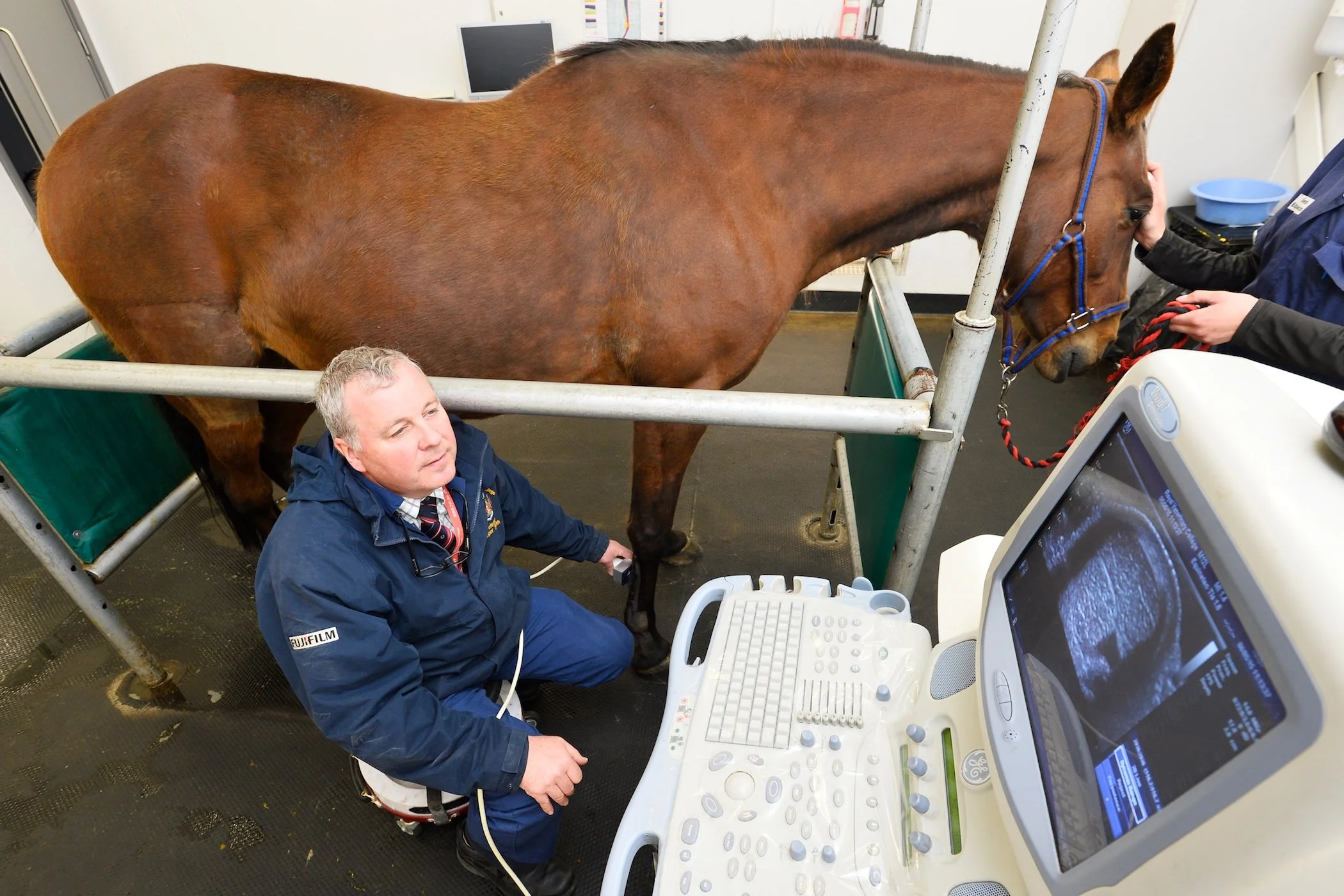Gerald Leigh Memorial Lectures 2025
The seventh renewal of the Gerald Leigh Memorial Lectures, in association with Beaufort Cottage Educational Trust took place at Tattersalls in Newmarket, England on June 4th.
The Gerald Leigh Charitable Trust was established in 1974, set up in memory of Gerald Leigh, a prominent owner breeder and best known for breeding the highly successful Barathea and Markofdistinction.
His legacy lives on through the trust, which not only reflects his remarkable achievements and lasting influence in the world of Thoroughbred breeding and racing, but also continues his deep passion for scientific advancement and the welfare of horses—both within the racing industry and the wider equine community. The trust stands as a testament to Gerald Leigh’s enduring commitment to excellence, care, and innovation in all aspects of equine life.
Wind ops- the decision making and diagnostics
Tim Barnett MRCVS of Rossdales Veterinary Surgeons, delivered two informative and interesting lectures on wind ops and the decision making and diagnostics relating to them. As we all know, wind surgery addresses upper airway conditions in horses that impair breathing and performance. Key anatomical structures involved include the arytenoid cartilage, vocal folds, epiglottis, and soft palate. Common issues include vocal fold collapse, often causing a whistling noise and linked to progressive recurrent laryngeal neuropathy “roaring”, which severely obstructs airflow. Another frequent problem is dorsal displacement of the soft palate (DDSP), where the soft palate flips over the epiglottis, blocking airflow and causing sudden loss of performance.
Palatal instability often precedes DDSP. Other conditions include medial deviation of the aryepiglottic folds, nasopharyngeal collapse, epiglottic entrapment, and ventral luxation of the arytenoid apex (VLAC). These disorders vary in severity and may be progressive or multifactorial. Barnett clarifies that although surgical interventions target these conditions, outcomes depend on the specific disorder and severity.
Upper airway conditions remain a major cause of poor performance in racehorses, with many requiring multiple surgical interventions. Accurate diagnosis, particularly via exercising endoscopy, is key, as many disorders only become apparent during physical exercise.
Tieback (prosthetic laryngoplasty) is the most common wind surgery but carries risks such as aspiration, pneumonia and swallowing dysfunction, despite efforts to improve surgical techniques. Newer techniques, like standing tiebacks and improved implants (e.g., titanium buttons, reinforced screws), aim to reduce complications and enhance results.
Other surgeries like Hobday (vocal fold removal via laser) were also discussed, emphasising the delicate nature of airway surgeries and the ongoing challenge to balance treatment effectiveness against risks and complications in our racehorses.
For DDSP, tie-forward surgery, which mimics natural muscle action to restore laryngeal position, has shown positive results, while thermocautery remains controversial. Epiglottic entrapment can now be safely corrected in standing horses using lasers or scissors. Emerging therapies include laryngeal reinnervation and dynamic neuroprosthesis to restore muscle function, as well as vocal fold filling to reduce aspiration pressure.
Collagen cross-linking is also under investigation as a less invasive method for soft palate stiffening. Barnett concludes, precise diagnosis and tailored interventions are crucial for optimal results in treating upper airway disorders in racehorses. These advances reflect a growing push for safer, more effective airway interventions in the racehorse.
Barnett then moved onto discussing the critical role of exercise endoscopy in diagnosing upper airway dysfunction in Thoroughbreds, highlighting the limitations of resting endoscopy. While useful for detecting conditions like total RLN, epiglottic entrapment, or arytenoid chondritis, resting scopes often miss dynamic issues such as soft palate disorders and vocal fold collapse.
Recent developments in overground endoscopy which are battery-powered and rider-compatible, allow evaluation during real time exercise, providing accurate and practical diagnosis. This method has become the preferred standard, especially for assessing palatal instability and early RLN.
Clinical signs such as respiratory noise, poor performance, or sudden stops may indicate airway dysfunction, but accurate diagnosis requires proper exercise testing with horses cantering or galloping while synchronising breaths per stride. Additional tools like laryngeal ultrasonography aid diagnosis and planning of treatment.
Barnett cautioned against performing airway surgery without thorough diagnostics, as multiple simultaneous conditions can exist, and treatments must be carefully targeted to improve outcomes. Around 25% of Thoroughbreds show clinical RLN, reinforcing the need for tailored, evidence-based treatment plans to support both welfare and performance.
Laryngeal surgeries - the evolution of research and engineering of the tie back and nerve graft
Dr Fabrice Rossignol, of Grosbois/Chantilly Equine Clinic discussed laryngeal surgeries, focussing on the evolution of research and engineering of the tie back and nerve graft. Rossignol’s specialist clinic is at the forefront of treating recurrent laryngeal neuropathy (RLN).
The condition is often linked to degeneration of the recurrent laryngeal nerve, affecting the cricoarytenoideus dorsalis (CAD) muscle, which is critical for opening the airway during exercise. Rossignol explains that this muscle contains few fatigue-resistant fibres, making it vulnerable to atrophy. Even minor narrowing of the airway significantly increases resistance, due to the exponential pressure effects described by Poiseuille’s law.
Diagnosis involves treadmill endoscopy and ultrasonography (caudal view of swallowing can be particularly useful) to assess dynamic airway collapse and muscle atrophy. Treatment is tailored to severity; advanced cases may require a tieback (laryngoplasty) using synthetic prostheses to partially open the arytenoid cartilage, though this risks complications like coughing. Newer techniques aim to restore function rather than replace it. One such innovation combines traditional tieback surgery with nerve grafting from the spinal accessory nerve, which activates during inspiration and contains fatigue-resistant fibres.
This hybrid approach improves airway opening and reduces side effects. Standing surgery under sedation allows more precise suture placement, minimising anaesthetic risk. Emerging technologies like 3D-printed implants and titanium screw anchors further enhance outcomes. Rossignol echoes Barnett’s earlier advice, that early intervention and careful case selection remain key to success.
Dr Rossignol continued on to discuss what and how we, as a racing industry, can learn from other disciplines.
Recent research in trotters and sport horses highlights how neck flexion contributes to dorsal and lateral pharyngeal collapse, likely due to nerve inflammation affecting muscles such as the stylopharyngeus. Nasal obstruction, including alar fold collapse and nasal muscle paralysis, also play a role in compromised airflow. Treatment options now include alar fold resection, nasal fenestration (widening), and innovative approaches like titanium mesh implants to replace lost muscular function.
Dr Rossignol explains that high-speed treadmill testing has proven critical in diagnosing dynamic airway conditions, while a multidisciplinary approach involving vets, trainers and farriers enhances management strategies. Use of nasal dilation devices, such as nasal strips, remains restricted under many jurisdictions' rules of racing.
It is clear that Rossignol champions cross-disciplinary learning, working with trotter trainers over decades has yielded practical insights, such as shoe removal to enhance performance. The methodical, detail-driven tack and equipment adjustments made in trotting disciplines provide valuable lessons in optimising performance.
Dr Rossignol also shares advances in surgical techniques, including refined approaches to epiglottic entrapment, emphasising the importance of collaborative care. Cross-disciplinary exchange continues to inform diagnosis, treatment and rehabilitation, enriching equine sports medicine and improving outcomes across disciplines.
An update on wind surgeries: what's new?
To conclude the lectures on wind ops, Mark Johnston, Dr Rossignol and Tim Barnett took to the floor to field audience questions. The discussion focused on recurrent laryngeal hemiplegia (RLN) in horses, highlighting its probable hereditary component but unclear linking between particular genes. Experts note the complexity of breeding influences and caution against oversimplifying genetic causes, as RLN will most likely be linked with other traits.
Surgery helps individual horses but may skew breeding populations, as generally only the more expensive stallions receive treatment. Disclosure of surgeries before breeding is debated but difficult to enforce. Non-surgical solutions like resistance masks are emerging but their impact on reducing surgery isn’t yet clear. Overall, understanding and managing RLN’s genetics and treatment remain challenging and unresolved.
Early diagnosis of recurrent RLN relies on ultrasonography to detect early muscle atrophy; surgery is recommended promptly to prevent irreversible damage. In contrast, dorsal displacement of the soft palate (DDSP) often stems from muscle fatigue, immaturity, or inflammation and is best treated medically with training and reinforcement until at least three years old. Surgery is a last resort if medical management fails.
Multiple surgeries can be ethical if done safely and explained clearly. Yearling wind testing is variable and challenging to interpret, complicating sales disclosures. The increase in buyers scoping foals’ pre-sale is seen as an invaluable and unpleasant practice due to solid evidence that a foal’s laryngeal physiology will and can change tremendously as they mature. Ongoing research explores novel therapies such as pacemakers and magnetic stimulation.
The practical management of tendon rehabilitation
There is no introduction needed for Mark Johnston, who kindly provided us with his insight on the practical management of tendon rehabilitation. A renowned trainer with decades of experience offered a pragmatic view on tendon injury rehabilitation in racehorses, challenging long-held optimism around recovery. Despite advancements in ultrasound imaging and a range of therapies, from anti-inflammatories to experimental interventions like carbon fibre implants, he is yet to witness a truly successful long-term return to peak performance in top-level racing following a diagnosed tendon injury.
While ultrasound provides valuable detail, he still relies most on visual and tactile assessment, particularly tendon profile and signs of ‘bowing,’ which he considers a critical turning point. In his experience, few flat horses make a full comeback; many may race again, but recurrent issues and shortened careers are the norm. Mark’s approach is rooted in realism: throw everything anti-inflammatory at the injury early, manage workload carefully, and temper expectations.
Long rest alone is rarely effective and controlled rehab and early, aggressive treatment are key. He notes that previous use of prophylactic anti-inflammatories post-race helped reduce injuries, and questions whether restrictions on racecourse treatments may hinder progress. Prevention, early detection, and practical management remain the trainer’s most reliable tools.
Tendon injuries in racehorses
Professor Roger K.W. Smith FRCVS presented a detailed lecture on tendon injuries in racehorses, focusing on the superficial digital flexor tendon (SDFT) and the role of science in improving prevention and rehabilitation strategies. As a key structure for locomotion, the SDFT functions as an energy-storing spring but operates near its mechanical limits, especially in Thoroughbreds, making it prone to injury from accumulated loading rather than acute trauma.
Research shows that degeneration often precedes clinical injury, particularly within the interfascicular matrix (IFM), which loses elasticity with age and training. Tendon cells also become less responsive with age, impairing repair. Matrix metalloproteinases (MMPs) are implicated in post-exercise matrix degradation, further weakening the tendon.
Professor Smith emphasised prevention through training adjustments: avoiding hard ground, spacing out intense work, and ensuring sufficient recovery of, ideally 72 hours. Early detection is critical. Diagnostic tools such as ultrasound, Doppler, and Ultrasound Tissue Characterization (UTC) can identify structural changes before injury becomes apparent.
When injury occurs, a prolonged, structured rehabilitation programme guided by regular imaging is essential. Biologic therapies like mesenchymal stem cells (MSCs) and platelet-rich plasma (PRP) are showing encouraging results, improving tendon structure and reducing re-injury rates. A personalised, biologically informed approach remains key to safeguarding tendon health in racehorses.
Tendinopathy - its causes, treatments and parallels between equine and human medicine
Lt. Col. Dr Tom Clack delivered a comprehensive lecture on tendinopathy, highlighting its causes, treatments, and parallels between equine and human medicine. Tendinopathy, a chronic overuse injury, follows a three-stage progression: reactive tendinopathy (early inflammation), tendon disrepair (structural change and neovascularisation), and degenerative tendinopathy (reduced symptoms but increased rupture risk).
Historically, eccentric loading exercises, which came about via human Achilles research, became the core treatment. Today, management is more tailored, focusing on biomechanics, load control, and personalised rehabilitation.
Diagnosis includes clinical evaluation and ultrasound, with advanced modalities like Shearwave elastography and UTC offering deeper insights into tendon integrity and healing.
Dr Clack advocated a multimodal treatment strategy: progressive loading, extracorporeal shockwave therapy (ESWT), and injectables such as corticosteroids (for short-term relief) and PRP, which supports healing through growth factors.
Crucially, he emphasised the value of Thoroughbred racehorses as models for human tendon injury. Their tendons endure similar high loads, and developments in imaging, PRP, and regenerative therapies in equine medicine are increasingly influencing human sports injury treatment.
Dr Clack echoed the importance of early detection, strategic recovery protocols, and ongoing collaboration between human and veterinary medicine to improve long-term outcomes in equine athletes.
Rehabilitating the equine athlete
We were then treated to a lecture by Veterinary surgeon Amelia MacArthur, who provided a grounded and insightful view on equine rehabilitation, shaped by her hands-on experience running a specialist rehabilitation yard in North Yorkshire. Based at the former training yard of Peter Beaumont, her facility includes a water treadmill, deep sand gallop, extensive hacking, and a quiet stable environment, all tailored to support recovery and performance conditioning.
It is clear that MacArthur advocates for a genuinely holistic approach, not rooted in fads, but in understanding the whole horse: injury history, temperament, conformation, previous management, and future athletic goals. Rehabilitation begins with controlled exercise, which is often hand-walking, though she acknowledges the safety challenges of managing fresh horses, advising use of protective gear and sedation when necessary. In-stable physiotherapy, such as weight-shifts and limb lifts, can supplement or replace walking early on.
She stresses that rehabilitation literature often lacks clarity, so individualised programs with regular reassessment, particularly ultrasound checks, are essential. Progressive loading, surface variation, and adapting treadmill use depending on injury type all help prevent reinjury. For tendon cases, treadmill work is delayed to avoid strain from reduced slip.
Crucially, MacArthur highlighted the impact of rider weight and balance, particularly for ex-racehorses, and the importance of body condition in supporting soundness. A striking case study showed how fat loss transformed a Highland pony’s tendon recovery and competitive ability.
Tendon injury; therapy and management
The final open floor discussion of the day took place between Mark Johnston, Professor Roger Smith, Dr Tom Clack and Amelia MacArthur. The topic of military-style training programmes running parallel with equine management were discussed, particularly in managing overuse injuries like stress fractures. Key strategies include load management and gradual conditioning over 4–8 week cycles. It was noted that today’s horses, like modern human recruits, can often lack natural conditioning, especially in the feet, increasing injury risk.
Prevention is focused on structured training that supports both tendon and bone development, particularly in young horses (yearlings), where tendons must adapt before bones are heavily loaded. Ground conditions and surface variation also play a complex role in musculoskeletal health.
Rehabilitation and pre-training approaches remain debated, but there's agreement that progressive, controlled exercise is essential. Tendon injuries, especially in flat racehorses, are notoriously hard to overcome. Advances in ultrasound and imaging, such as UTC and shockwave elastography offer new promise, though they come with high costs and technical demands.
National Hunt horses often return to competition successfully after injury, offering hope, but managing owner expectations remains key. Medication use, such as dexamethasone, is tightly regulated on racecourses to uphold integrity. Like elite human athletes, horses need carefully balanced workloads and rest to prevent chronic damage. While rehabilitation methods are improving, prevention remains the best strategy.
This year’s renewal of the Gerald Leigh Memorial Lectures was once again full to the brim with exciting new research and innovative thoughts from world leading experts. Attendees, all involved within various areas of the horseracing industry made for diverse and thought-provoking discussions.
The commonality amongst the lecturers and attendees alike was the undeniable commitment to ensuring the betterment of equine welfare in all avenues of bloodstock, racing and life after. Safe to say, all who attended are already looking forward to the 2026 lectures.
What is equine welfare? Asks Johnston Racing’s vet Neil Mechie
Neil Meche
The world of equine welfare—and animal welfare in general—is a proverbial can of worms. Decisions regarding equine welfare must be made on logical scientific evidence and not be biased by emotion or fear of incorrect perceptions in the media or public eye. As with many things in life, education is the key, especially in a world where large parts of the population have very little experience or knowledge of keeping or working with animals.
The welfare of animals is protected in national legislation in the UK. The Animal Welfare Act 2006 makes owners and keepers responsible for ensuring that the welfare needs of their animals are met. These include the need:
for a suitable environment (place to live)
for a suitable diet (food and water)
to exhibit normal behaviour patterns
to be housed with, or apart from, other animals (if applicable)
to be protected from pain, injury, suffering and disease
Reading these concise bullet points, one would think it quite simple to meet these needs, but issues arise when it comes to interpreting and putting this guidance into practice.
As an insight into how emotive language can change the interpretation of animal welfare requirements, below are the The Royal Society for the Prevention of Cruelty to Animals (RSPCA) “Five Freedoms,” which are not too dissimilar to the above but portrayed in a different light:
Freedom from hunger and thirst
Freedom from discomfort
Freedom from pain, injury or disease
Freedom to express normal behaviour
Freedom from fear and distress
The RSPCA is a charity champions animal welfare, and the use of words such as hunger, thirst, discomfort, fear and distress conjure up images of tortured animals wasting away in squalor. There is no need for this dramatic language when the preservation of welfare only actually requires common sense and compassion.
The same can be said when considering the welfare of horses, but sadly this is not the case. The biggest welfare issues facing the horse population are not, as the media would have you think, horses breaking their legs on racetracks or the travelling community mistreating horses at Appleby Fair. It is obesity and the mis-management of horses in the general population. Every day horses are being killed by a plethora of issues caused by over-feeding and poor management regimes. Laminitis, colic and numerous hormonal and metabolic diseases negatively affect the welfare of thousands of horses each year and are in a large part caused by the poor knowledge and horsemanship of their owners. It is now a large part of most equine vets’ job to educate horse owners on appropriate feeds and management regimes for their horses.
Racehorses, on the contrary, are looked after with the highest of standards as they are athletes competing at a high level.
BUY THIS ISSUE IN PRINT OR DOWNLOAD
WHY NOT SUBSCRIBE?
DON'T MISS OUT AND SUBSCRIBE TO RECEIVE THE NEXT FOUR ISSUES!
The FEI prohibited list and what it means for racing
By Alysen Miller
The eighth World Equestrian Games in Tryon, North Carolina were not, it is perhaps fair to say, an unbridled success. From unfinished facilities to misspelt signage and, most catastrophically, an entire endurance race that had to be aborted after riders were sent in the wrong direction, the competition generated so much negative coverage that the future of the Games themselves, already in some doubt, now appears to be hanging by a thread (At the time of writing, no formal bidders had thrown their hats into the ring for the 2022 renewal). So it might seem to be a strange time to ask if horseracing has anything to learn from the Fédération Équestre International (FEI). And yet, there is one area in which the FEI is arguably setting an example.
Unlike the global racing industry, which operates under myriad rules and regulations between different countries (and sometimes within the same country), all 134 affiliated nations of the FEI operate under a single set of rules. This includes a single Prohibited Substances Policy to which all jurisdictions must adhere; meaning that a horse trained in Australia is subject to exactly the same medical requirements, including regulations governing banned substances and threshold limits, as a horse trained in, say, America. This stands in stark contrast to the thoroughbred industry. Despite being an increasingly global game, from the now-traditional annual American invasion of Royal Ascot to the recent domination of the Melbourne Cup by European-trained horses, racing can appear positively parochial when it comes to its attitudes towards prohibited substances. “If you compare horseracing to other sports, we have one of the sole sports where there are no equal regulations on the highest level,” elucidates Germany’s Peter Schiergen. “To have [the same] regulations and policies around the world would be a good action for horse racing.”
So what are the factors standing in the way of global harmonisation, and would there ever be a case for following the FEI’s lead and adopting a single set of rules that would apply to horseracing authorities the world over?
Laboratory sample analysis
The FEI’s approach is to divide prohibited substances into two categories: banned substances (that is, substances that are deemed by the FEI to have no legitimate use in competition and/or have a high potential for abuse, including all anabolic steroids and their esters), which are not permitted at any time; and controlled medication (substances that are deemed to have a therapeutic value and/or are commonly used in equine medicine), which are not permitted for use during competition but may be used at other times. These categorisations apply to all national and international competitions, with each national federation being subject to the FEI’s regulations. Testing at competitions is carried out by the FEI’s own veterinary department, while elective out-of-competition testing is also available so that those responsible for the horse can ensure that they allow the appropriate withdrawal times for therapeutic medications. So just how effective are these rules at keeping prohibited substances out of the sport and ensuring a level playing field? Clearly, no system is perfect. The FEI has had its fair share of doping scandals, particularly in the endurance discipline, where stamina, which can be easily enhanced with the aid of pharmacology, is of paramount importance. The FEI, who declined to be interviewed for this article, said in a statement: “Clean sport is an absolute must for the FEI and it is clear that we, like all International Federations, need to continue to work to get the message across that clean sport and a level playing field are non-negotiable. All athletes and National Federations know that regardless of where in the world they compete the rules are the same.” Yet having a global policy does appear to offer a strategic advantage to those seeking to create a level playing field, not only through the creation of economies of scale (the FEI oversees laboratories around the world, and all results are all handled at the federation’s headquarters in Lausanne), but also by creating a framework for cheats to be exiled from all competitions, rather than just one country’s.
While harmonisation and cross-border cooperation does exist in racing, particularly within Europe and individual race meetings—notably the recent Breeders’ Cup—have taken it upon themselves to enact their own programme of pre- and post-race testing, effectively creating their own anti-doping ecosystem; the fact remains that racing lacks an overarching prohibited substances policy. Codes and customs vary widely from—at one end of the spectrum—Germany, which does not allow any colt that has run on declared medication to stand at stud; to North America, where, Kentucky Derby winner Big Brown, whose trainer admitted that he gave the colt a monthly dose of the anabolic steroid, stanozolol, is still active at stud. Stanozolol is the same drug that the Canadian sprinter Ben Johnson tested positive for in 1988, causing him to be stripped of his gold medal in the Seoul Olympics. Although the industry subsequently moved to outlaw the drug for use on horses in training, anabolic steroids are still routinely used as an out-of-competition treatment in a number of states.
“I don’t think the playing field is level,” says Mark Johnston, with typical candour. “Control of anabolic steroids is very important if you want a level playing field. Because there’s no doubt whatsoever that there are advantages to using them.”
















